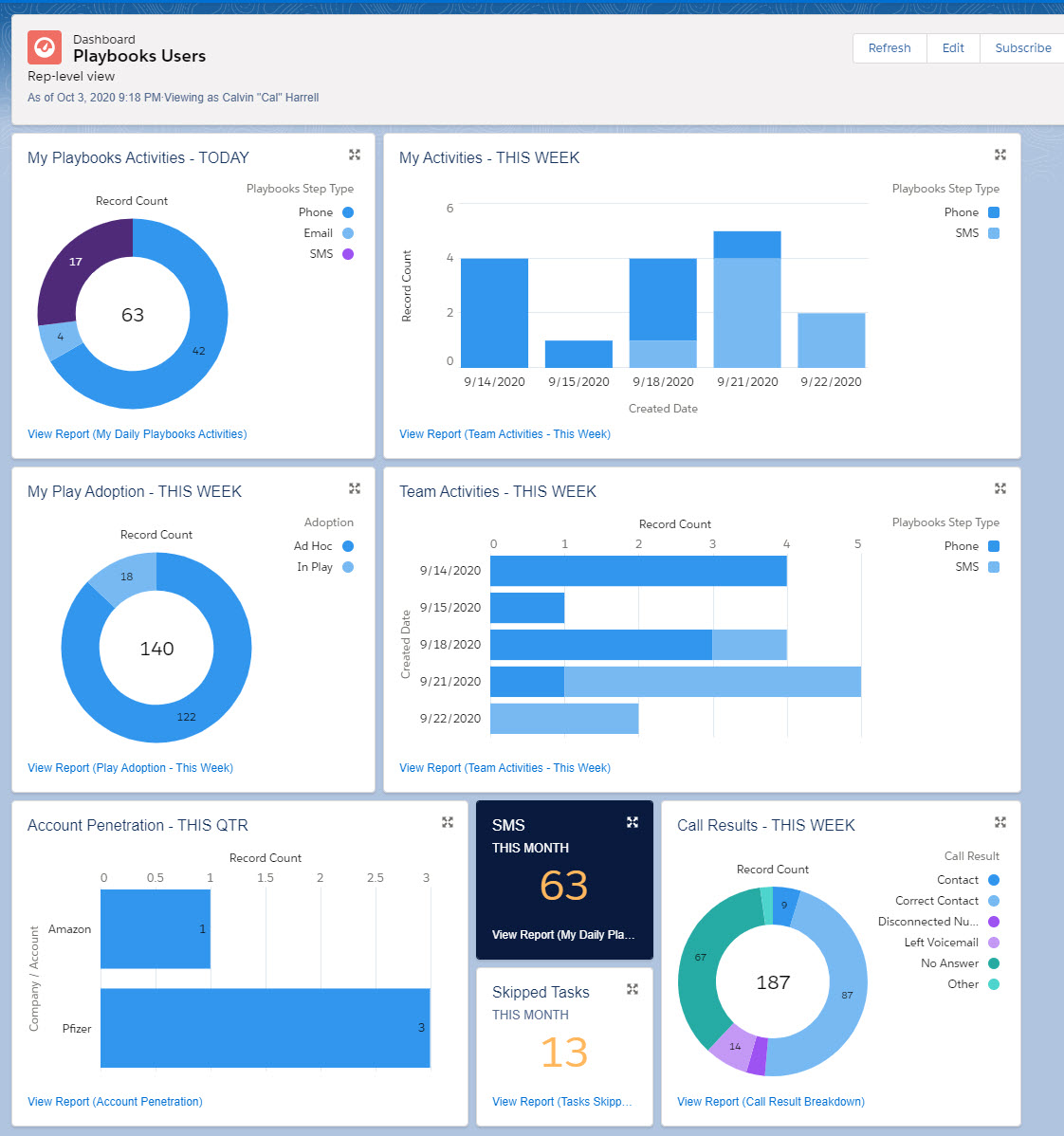Salesforce Reporting Best Practices
What to consider and things to avoid while creating reports
There are many reports you can run that combine Playbooks and CRM data and many ways to interpret the data presented in those reports. But before you make changes to your sales process based on this reporting, consider if you are tracking the right metrics. Are you tracking things that will improve your approach with prospects and customers or are your tracking things that don’t matter to your bottom line?
Common Reporting Mistakes
When creating reports, avoid these common mistakes. While they seem like a clear-cut way to measure productivity and effectiveness, using these types of reports to create or modify your strategies can have unintended consequences.
Top 7 Reporting Mistakes
- Measure success by dials. Reps are not hired to place calls; they are hired to have conversations that lead to sales. When you push your team to make dramatically more dials, you will inadvertently lower talk time. You will also see less ring time as the reps won’t wait long enough to get someone on the phone. Both outcomes represent a decrease in conversations which is the true goal of the placing a phone call.
- Measure success by list completion. A policy that promotes reps getting to the end of a list produces bad behavior. Like with measuring success by dials, measuring list completion will incentivize reps to choose tasks by how quickly they can be completed not by how effective they are.
- Too many KPIs. When you are tracking too many KPIs, you lose track of what is actually important to target. Think about what is important to your team and your team’s maturity. Are you just learning to adopt Playbooks or are you implementing a new Play or Priority Score? The KPI you chose 6 months ago may not be the one you need to focus on today. It’s best to pick your top 3 KPIs, but you can effectively choose up to 5 to focus on.
- Using reports as an accountability tool. Reports are useful to identify which reps are performing well and which are struggling, but you should also use reports to evaluate if the strategy is working or not. Even the strongest reps will struggle if the process is flawed.
- Too many emails. Don’t rely solely on email. While email is a useful tool, it’s often utilized too much. Multi-channel communication is best and leads to better results. Make sure your sales strategy incorporates calls, SMS, and LinkedIn connection as well as emails.
- Mixing call dispositions and lead dispositions. Mixing these two will jeopardize your data. Lead statuses are not transactional and should not change unless the lead is moving up or down the funnel. Otherwise you end up with too many lead statuses that create ambiguity for reps trying to move as quickly as they can. Then you have clouded data that can’t tell a concise story.
- Measure success by number of contacts. Again, quality, not quantity, is key when measuring meaningful connections. Tracking any contact doesn’t show the whole picture. You can contact a customer and have the conversation go nowhere or you can contact a gatekeeper and not make progress in the sales process. Correct contacts AND their talk time on calls with those correct contacts more accurately shows the level of engagement those contacts have.
Reporting should be nuanced. There is no single report that can be used to indicate how your reps and sales strategies are performing. You should build multiple reports that can be pulled into a feedback loop. Start by analyzing effort and figure out what tasks your team is performing. Then, determine what is the effect of those activities. Are the results positive or negative? Next, analyze those results and create a strategy or next steps for your team.
Top 6 Insightful Reports
Here are 6 Insightful Reports, recommended by our Senior Technical Consulting Team. Click the title of the report to be taken to more information on this report.
- Correct Contact by Time of Day and Day of Week – These reports shows when are you getting the most correct contacts or speaking to the right person in the prospects’ time. Playbooks technology can help you organize your day to make sure that you are always calling people at the most optimized time for your prospect.
- Call Result Details – Who on your team is having conversations with the right people and who needs coaching? This report plots your users’ Call Results on a plot map using the percentage of total calls as the X axis and average call duration as the Y axis. See the video above for help reading this chart.
- Best Email Templates – Which email template is getting the most customer engagement? Test a couple of email templates side-by-side to determine which one should be used as the final email template. Make sure to check for both open and response rates to create a template that is truly effective.
- Activities Completed by Priority Score Bucket – Get to the heart of ‘effort vs. results’ by determining which Playbooks users are spending energy on lead records most likely to convert. This valuable reporting is only available with XANT Conversion scoring models, which are freely available to ALL Playbooks customers starting November 2020.
- Play Success by Play Step Number – Measure the success of not only each Play, but each Play step along the lead’s journey. Use the data from this Play to encourage reps to stay persistent in the Plays that pay off after longer engagement and to decide when a Play has reached its natural conclusion and it’s time to call it quits.
- My Activities Today – This report is for Playbooks users. Have users review this report to see what they’ve completed today. Use the report details to easily find call recording links and see which emails have already generated open notifications or link clicks.
Creating a Dashboard
To help manage all the reports you may be tracking, try creating one or multiple dashboards. There are lots of articles about Salesforce Dashboards that can offer some general but good advice, but here are our 3 tips for Salesforce Dashboards as it relates to Playbooks.
- Don’t mix activity dashboards with Play success dashboards. Each view should tell a specific data story otherwise too much data is presented at once and the focus is lost. We recommend keeping dashboards simple and short enough you don’t need to scroll. Pick what is important.
- Standardize dashboards as much as possible to help save time and resources. If several teams are using Playbooks, create one dashboard (during the Playbooks implementation project) for a test group, get feedback and iterate. Then replicate the dashboard for each team and set the dashboard to ‘Run as the Manager’. Many Sales Operation teams must create and support Salesforce dashboards for many teams of viewers with different roles, and KPMs. Standardizing helps to save Operation team resources.
- Add dashboards to the Home tab in Salesforce to ensure easy access and visibility. Have your main reports be the first thing users see when they log in to Salesforce. Then, users can easily jump back to the most essential reports anytime they are in Salesforce.


